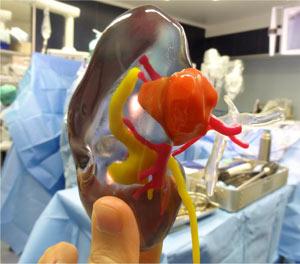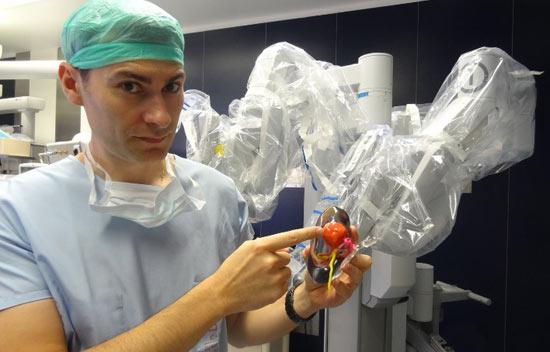 3D printing’s medical breakthroughs only seem to be starting. It’s a natural fit, after all, as we watch more doctors and patients benefit from the high-quality models that ensure more precise surgeries. Surgeons are better prepared and patients can rest assured that their procedures are less likely to have complications when 3D printed models are used in surgery preparations across the world.
3D printing’s medical breakthroughs only seem to be starting. It’s a natural fit, after all, as we watch more doctors and patients benefit from the high-quality models that ensure more precise surgeries. Surgeons are better prepared and patients can rest assured that their procedures are less likely to have complications when 3D printed models are used in surgery preparations across the world.
One recent example of the use of 3D printing is in France this time, as University Hospital (CHU) de Bordeaux doctors from the Department of Urology and Kidney Transplantation have recently used 3D printed kidney models for complicated tumor removals. These models do three things: prepare surgeons for specific surgeries, train surgeons generally, and they are used to communicate with patients who want to know as much as possible about the procedure that is planned.
Dr. Jean-Christophe Bernhard, a CHU surgeon, states that the hospital is ‘one of the first in the world’ to use Stratasys‘ multimaterial and multi-color 3D printing technology (the Stratasys Objet500 Connex3) for cases involving kidney tumor removal. Dr. Bernhard states:
“Having a 3D printed model comprising the patient’s kidney tumor, main arteries and vessels – each in a different color – provides an accurate picture of what we will see during operations. The ability to visualize the specific location of a tumor in relation to these other elements, all in three dimensions, greatly facilitates our task and is not something that is easily achievable from a 2D scan.”
As you can see from the doctor’s comments, color matters here. It allows the surgeon to distinguish between different parts of the kidney, and it also includes attached arteries and vessels.
The goal in this kind of kidney surgery is to spare the vessels and arteries, but if there are complications in this department, then the patient could feasibly suffer from chronic kidney disease. Dr. Bernhard compares the process of using 2D scans and 3D prints in surgery preparation and he concludes that 3D printed models work much better to help guarantee precision:
“…having a 3D printed kidney model in your hands that corresponds specifically to that of the patient you’re going to operate on quite literally offers me a view from a new perspective. The only thing more accurate than that is the patient himself.”
Right now, the colors that are used to 3D print the different parts of the kidney are as follows: transparent VeroClear is used to show the kidney’s volume mass, yellow is used for the kidney’s excretory tract, and red is used for the arteries. When surgeons observe models with these very carefully delineated organ parts marked by color, they know what to expect to see under the knife, thus promoting the possibility of sparing the organ under sometimes difficult surgical challenges.
Of course, as previously mentioned, all of this is good for more than general surgical training and communicating with the patient. These models also greatly assist in student learning, as described by Dr. Bernhard:
“Having access to a 3D printed model that is completely accurate to the one on which you’re going to operate not only enables you to train yourself on the operation, but it also greatly improves our ability to more accurately convey surgical procedures to students – who, of course, are the surgeons of tomorrow.”
Finally, patients greatly benefit since the models show them exactly where the tumor is located and the surgeon’s intentions. Dr. Bernhard states that patient understanding of the surgery is increased by 50 percent–a huge improvement–according to recent information gathered by questionnaires.
So, as Stratasys 3D printing technology makes great strides to improve medical services through 3D modeling, the patients also benefit from the ability to view their own kidneys and see exactly where operations will occur. More details on this story may be found here.
Subscribe to Our Email Newsletter
Stay up-to-date on all the latest news from the 3D printing industry and receive information and offers from third party vendors.
You May Also Like
Air Force Awards Fortius Metals $1.25M to Qualify 3D Printing Wire for Hypersonic Applications
AFWERX, part of the US Air Force Research Laboratory (AFRL), awarded a Direct-to-Phase II Small Business Innovation Research (SBIR) contract worth $1.25 million to Colorado’s Fortius Metals, to accelerate qualification...
US Air Force Awards JuggerBot $4M for Large-format Hybrid 3D Printing
Large-format 3D printer manufacturer JuggerBot has received a $4 million grant to develop a large format 3D printer, courtesy of the Under Secretary of Defense, Research and Engineering Manufacturing Technology...
Where Have All AM’s Unicorns Gone?
In the rapidly evolving world of 3D printing, startups valued at over a billion dollars, known as unicorns, once seemed as fantastical as the mythical creatures themselves. While a few...
How My Childhood Fascination with Planes Led to Investing in 3D Printing
My fascination with aerospace started young, and I started studying planes–identifying them in the sky and learning everything I could about how they work. Fast forward to my first week...

































